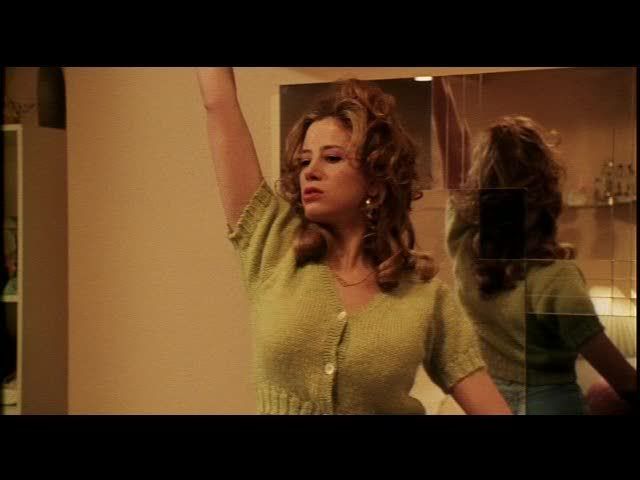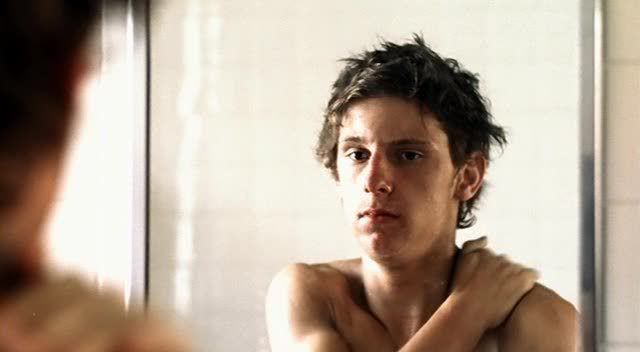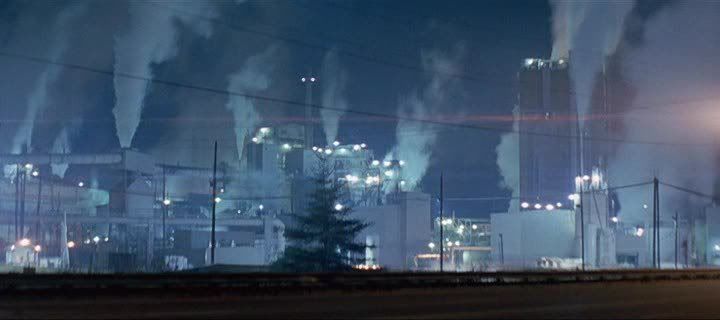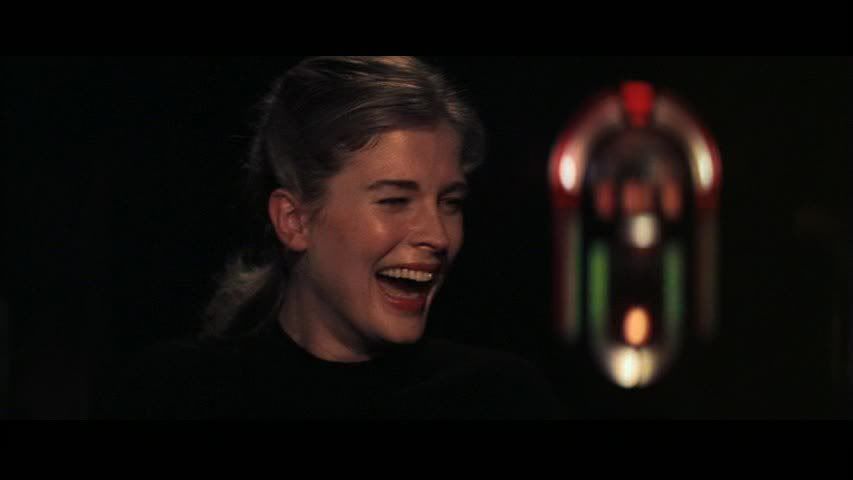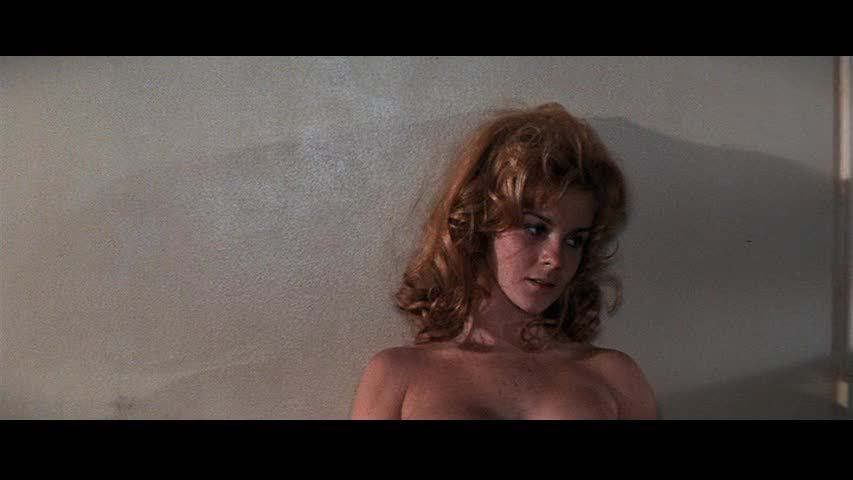
In his penultimate film, Wittgenstein, Derek Jarman attempts to grapple with the life and ideas of the brilliant, tortured philosopher Ludwig Wittgenstein, applying to the great man's life a framework that can only be described as the mingling of avant-garde theater with the aesthetics of a children's TV show. Most biographical and historical films attempt to rigorously capture a sense of the subject's life and times, to place the subject in context, to recreate his surroundings. Jarman rejects this historical realism out of hand, setting his film on an empty sound stage with a black curtain in the background, blotting out all extraneous detail. The sets are correspondingly meager and simple, usually consisting of a single prop that is needed for the scene at hand — a chair, a bed, a table, a piano, only occasionally a more complete range of furniture at Wittgenstein's seminars, where students are ranged around his blackboard in chairs. Furthermore, the wardrobe is defiantly ahistorical, ranging from Wittgenstein's plausible and conservative suits to the single-color sweatsuits favored by his sometime lover Johnny (Kevin Collins), to the brightly colored garments worn by much of the rest of the cast. Primary colors abound, vibrant hues that serve to separate Wittgenstein from those around him, and the film as a whole from the historical story it purports to tell — the ridiculous costuming of the cast would be most at home in an 80s dance club maybe, or else a surreal children's show. This is a film that dresses up the philosopher Bertrand Russell (Michael Gough) in a bright purple bow-tie and primary-red robes, seemingly just because it can. These philosophers and great thinkers look like they'd be more at home on Sesame Street than a Cambridge lecture hall. There's also no sense of real time or narrative, only a sequence of incidents and idiosyncratic ruminations on Wittgenstein's ever-changing thinking about the nature of the world and the way language is related to it. This elimination of context puts the focus completely on Wittgenstein himself, his relationships, his thoughts, and his internal dramas.
Wittgenstein himself is played by two actors: Clancy Chassay, who plays the philosopher as a young boy and provides bemused narration and interludes, and Karl Johnson, who plays the older Wittgenstein. The former is responsible for many of the film's more playful touches, and he opens the film by introducing himself, his bourgeoisie family, and the many tutors who are enlisted to teach him as a boy. He also engages in philosophical dialogues with a deformed Martian (the disabled actor Nabil Shaban) in a luminescent green costume, who questions him about basic concepts: how he knows the earth exists, whether he has ten toes, and what he thinks it means to say he is "a human." These scenes establish, through this ludicrous pairing, the way in which philosophy attempts to question even basic concepts, to start from no assumptions and work outwards from that empty space. The alien, who should really not exist, sets the film's tone: nothing can be assumed, an axiom that's driven home by Wittgenstein later in the film when he poses the old question about the sun going around the earth versus the earth going around the sun. Everyone used to assume the former, simply because that was the way it looked, but what, he asks, would it look like if it were the latter? From the perspective of the earth, of course, either model for the solar system looks the same. Nothing can be assumed, not even the evidence of the senses, a condition that leads Wittgenstein through the most tremendous self-doubt and internal strife in his pursuit of a comprehensive philosophy.
Jarman dramatizes this struggle almost in a vacuum. Incidents from Wittgenstein's life appear, disconnected from the whole: he leaves home, goes to war, writes his master treatise the Tractatus Logico-Philosophicus, becomes a rural elementary school teacher, and finally settles in at Cambridge as a professor, continuing to think all the while. It's a film, essentially, about thinking, a problem for a visual medium that Jarman solves by stripping down the surroundings and infusing the simple sets and costumes with as much color and vibrancy as he can muster. There are flashes of inexplicable visual bravado, like the scene where the society lady Ottoline Morrell (Tilda Swinton) is made up with yellow and blue patterns painted on her face. In the rest of the film, the character is made up more prosaically but no less completely, her face a pasty white mask with devilish red lips, while her clothes are among the brightest and frilliest in the cast. Why? Who knows, but this visual extravagance sets off her privileged world from the stubbornly proletariat Wittgenstein, whose greatest ambition is to abandon philosophy and become a manual laborer.

These kinds of disjunctions show up again and again within the film. In one scene, Wittgenstein dons a pair of white wings, attempting to fly as he holds a pair of lawn sprinklers in front of him, their twirling heads sending out circular sprays of water that flow into one another and form hypnotic patterns in the air, the droplets illuminated by hidden lights. It's strangely beautiful, but again, why is it here at all? Many of Jarman's interjections into the story of Wittgenstein are puzzling in the extreme, devoid of context as the whole film is. His visual sensibility seems calculated to be off-putting and unsettling, with its queasy mishmash of tastelessly combined colors and clothes, and the occasional detours into surrealist imagery that seem totally unrelated to the film's central story. Visually, the film might be described as an attempt to find the sublime within the ugly and tacky, a feat that Jarman sporadically accomplishes. His set and costume design frequently verge into absurd beauty, as in the scene where the economist Maynard Keynes (John Quentin), dressed in a ridiculous electric blue suit, meets with his aging ballerina wife (Lynn Seymour) whose graceful movements in a frilly blue costume turn the scene into a dance in sympathetic colors.
In addition to its engagement with Wittgenstein's ideas, the film also deals with the philosopher's conflicted sexuality, which seems to have caused him as much anguish as his considerations of philosophical problems. The film suggests that this was a man who brought the same laser-like logical intellect to bear on every aspect of his life — when designing a house for his sister, he planned it down to details as small as hinges and doorknobs. His sexuality, then, is given equally intense scrutiny, and he struggles with the conflicting pleasure and guilt he feels over his homosexual affairs, unsure of whether he's doing wrong or not. The film's other characters seem to have less trouble with such basic problems, and in some ways the film questions the importance of philosophy at all, much as Wittgenstein did at various points in his life. In one scene, Keynes and Johnny, who are also lovers, share a kiss, which Johnny laments cannot be explained by philosophy. Keynes is less perturbed, declaring that it's not meant to be explained, implying that some parts of human experience are beyond the realm of understanding. Wittgenstein cannot so easily accept this, cannot tolerate aspects of the world being roped off from analysis and explication, and the film's unanswered central question is whether Wittgenstein or Keynes is right on this point.
This is obviously a very complex and fascinating film, all the more so for the way in which it leaves such crucial questions unresolved. Wittgenstein's philosophy is presented in his own fumbling, often contradictory words, taking shape throughout the film as he postulates and then rejects new theories and new ways of understanding the world. The final scene visualizes this mental process in terms of the conflict between a rigorous, totally logical understanding of the world (a world of pure ice as represented by a giant snowman) and a more rough-edged, realistic view of the world with all its complications intact. This latter view, clearly the one favored by Jarman, is represented by the only point in the film in which the black curtain of the backdrop is peeled back. The young Wittgenstein, that mischievous philosopher-child, throws back the curtain to reveal a painted sunset, an icon for the beauty of the world. It's also a symbol of the film's endless cycle of explanations and thinking, a process that moves ever closer to the world without quite reaching it. Even here, the curtain is pushed aside but an equally artificial backdrop lies underneath. As a metaphor for the strivings of philosophy, always seeking to fully understand the world and always coming up against illusions and barriers, it's a nearly perfect way to end the film.

